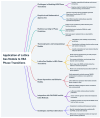Phase Stability and Transitions in High-Entropy Alloys: Insights from Lattice Gas Models, Computational Simulations, and Experimental Validation
- PMID: 40422419
- PMCID: PMC12111454
- DOI: 10.3390/e27050464
Phase Stability and Transitions in High-Entropy Alloys: Insights from Lattice Gas Models, Computational Simulations, and Experimental Validation
Abstract
High-entropy alloys (HEAs) are a novel class of metallic materials composed of five or more principal elements in near-equimolar ratios. This unconventional composition leads to high configurational entropy, which promotes the formation of solid solution phases with enhanced mechanical properties, thermal stability, and corrosion resistance. Phase stability plays a critical role in determining their structural integrity and performance. This study provides a focused review of HEA phase transitions, emphasizing the role of lattice gas models in predicting phase behavior. By integrating statistical mechanics with thermodynamic principles, lattice gas models enable accurate modeling of atomic interactions, phase segregation, and order-disorder transformations. The combination of computational simulations (e.g., Monte Carlo, molecular dynamics) with experimental validation (e.g., XRD, TEM, APT) improves predictive accuracy. Furthermore, advances in data-driven methodologies facilitate high-throughput exploration of HEA compositions, accelerating the discovery of alloys with optimized phase stability and superior mechanical performance. Beyond structural applications, HEAs demonstrate potential in functional domains, such as catalysis, hydrogen storage, and energy technologies. This review brings together theoretical modeling-particularly lattice gas approaches-and experimental validation to form a unified understanding of phase behavior in high-entropy alloys. By highlighting the mechanisms behind phase transitions and their implications for material performance, this work aims to support the design and optimization of HEAs for real-world applications in aerospace, energy systems, and structural materials engineering.
Keywords: HEAs; computational modeling; high-entropy alloys; lattice gas models; mechanical properties; phase stability; phase transitions.
Conflict of interest statement
The author declare no conflict of interest.
Figures






Similar articles
-
Exploring high entropy alloys: A review on thermodynamic design and computational modeling strategies for advanced materials applications.Heliyon. 2024 Oct 28;10(22):e39660. doi: 10.1016/j.heliyon.2024.e39660. eCollection 2024 Nov 30. Heliyon. 2024. PMID: 39619588 Free PMC article. Review.
-
Nanoscale high-entropy alloys for solar and thermal applications.Nanoscale. 2025 Mar 13;17(11):6266-6286. doi: 10.1039/d4nr04697h. Nanoscale. 2025. PMID: 39950602 Review.
-
Advances in Nickel-Containing High-Entropy Alloys: From Fundamentals to Additive Manufacturing.Materials (Basel). 2024 Aug 2;17(15):3826. doi: 10.3390/ma17153826. Materials (Basel). 2024. PMID: 39124490 Free PMC article. Review.
-
Scaling laws for lattice distortions: Application to high entropy alloys.PNAS Nexus. 2024 Mar 18;3(4):pgae117. doi: 10.1093/pnasnexus/pgae117. eCollection 2024 Apr. PNAS Nexus. 2024. PMID: 38562582 Free PMC article.
-
Three-dimensional atomic structure and local chemical order of medium- and high-entropy nanoalloys.Nature. 2023 Dec;624(7992):564-569. doi: 10.1038/s41586-023-06785-z. Epub 2023 Dec 20. Nature. 2023. PMID: 38123807
References
-
- George E.P., Curtin W.A., Tasan C.C. High entropy alloys: A focused review of mechanical properties and deformation mechanisms. Acta Mater. 2020;188:435–474. doi: 10.1016/j.actamat.2019.12.015. - DOI
-
- Ikeda Y., Grabowski B., Körmann F. Ab initio phase stabilities and mechanical properties of multicomponent alloys: A comprehensive review for high entropy alloys and compositionally complex alloys. Mater. Charact. 2019;147:464–511. doi: 10.1016/j.matchar.2018.06.019. - DOI
-
- Li W., Xie D., Li D., Zhang Y., Gao Y., Liaw P.K. Mechanical behavior of high-entropy alloys. Prog. Mater. Sci. 2021;118:100777. doi: 10.1016/j.pmatsci.2021.100777. - DOI
-
- Dai J.H., Li W., Song Y., Vitos L. Theoretical investigation of the phase stability and elastic properties of TiZrHfNb-based high entropy alloys. Mater. Des. 2019;182:108033. doi: 10.1016/j.matdes.2019.108033. - DOI
-
- Harrington T.J., Gild J., Sarker P., Toher C., Rost C.M., Dippo O.F., McElfresh C., Kaufmann K., Marin E., Borowski L., et al. Phase stability and mechanical properties of novel high entropy transition metal carbides. Acta Mater. 2019;166:271–280. doi: 10.1016/j.actamat.2018.12.054. - DOI
Publication types
Grants and funding
LinkOut - more resources
Full Text Sources

